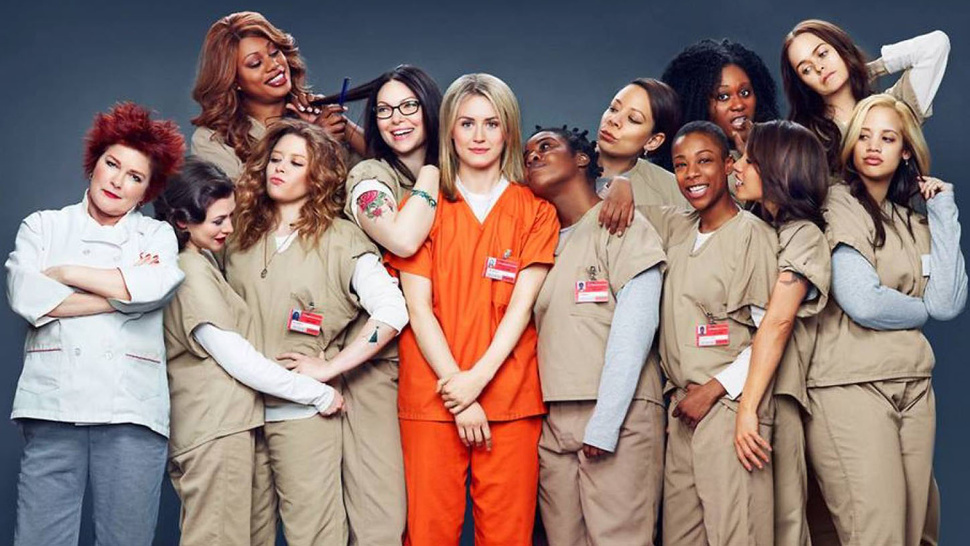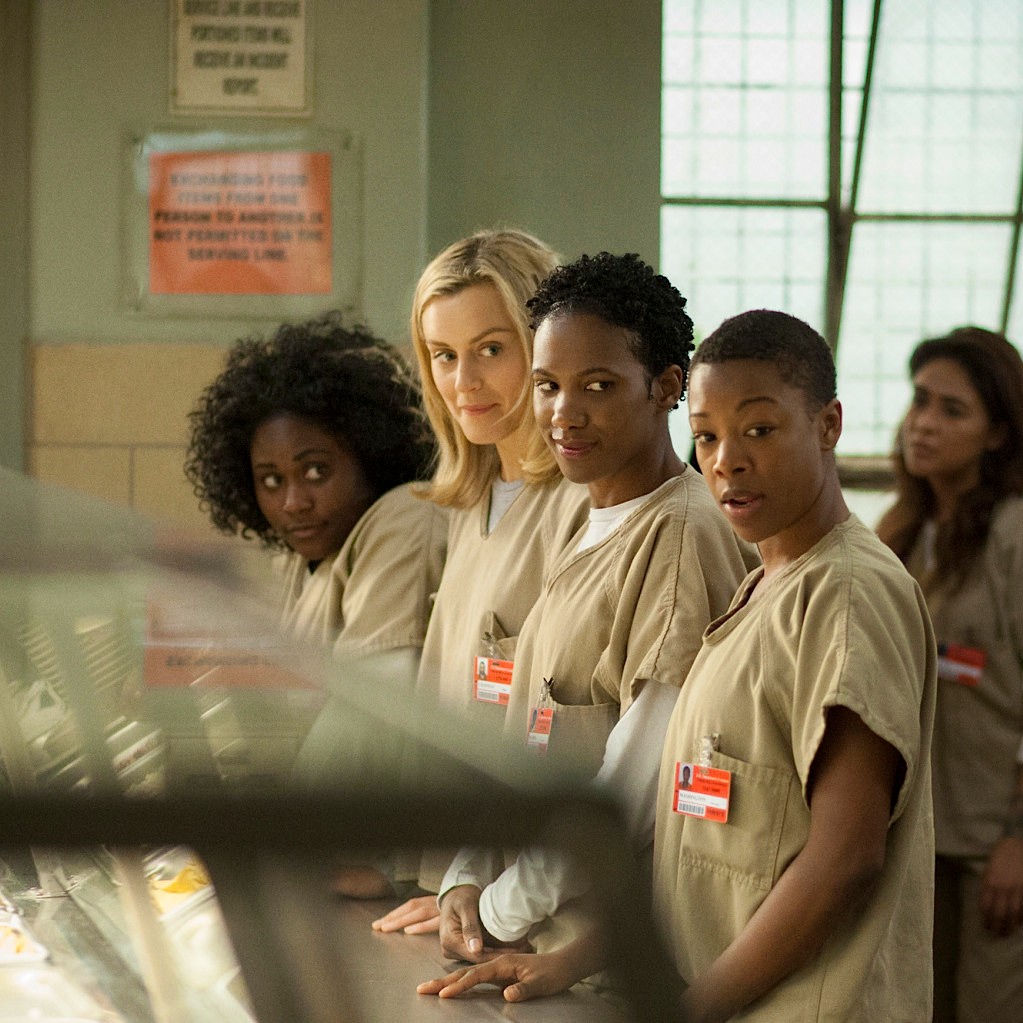 I’ve been binge-watching (is that what it’s called?) the Netflix series Orange Is the New Black for the last week, especially since I just moved to a small Midwestern town and my laptop is one of my only pieces of furniture. It’s great. It’s hilarious, the characters are super compelling, the actresses are beyond amazing. It’s an almost all-female cast. It has a great Regina Spektor opening which is NONSTOP IN MY HEAD (“Taking steps is easy / Standing still is ha-a-ard!”).
I’ve been binge-watching (is that what it’s called?) the Netflix series Orange Is the New Black for the last week, especially since I just moved to a small Midwestern town and my laptop is one of my only pieces of furniture. It’s great. It’s hilarious, the characters are super compelling, the actresses are beyond amazing. It’s an almost all-female cast. It has a great Regina Spektor opening which is NONSTOP IN MY HEAD (“Taking steps is easy / Standing still is ha-a-ard!”).
The series follows the trials and tribulations of protagonist Piper Chapman (Taylor Schilling), a Smith-educated wasp in her late twenties or early thirties who, while ostensibly living a stable yuppie life with her clean-cut Jewish writer fiancé (Jason Biggs), once had a serious relationship with a badass lesbian drug smuggler (Laura Prepon) which resulted in her transporting drug money across the ocean. Now, years later, she’s been convicted and is serving fifteen months in minimum security women’s prison. We see her voluntarily “surrender” to the prison, looking extremely out of place and comparing her new prison-issued slippers to Tom’s shoes.
Immediately, she’s thrown into a world of bizarre rules, barter systems, creative use of commissary resources, pronounced racial divides, and variously corrupt prison officials, and must learn to navigate it, to often humorous, sometimes tragic, effect. Plus—fun pre-prison flashbacks that spotlight a different character each week.
The thing about this series, and the reason that it’s been the subject of a lot of interesting conversations since it began, is that it has a lot of problems, but it has a lot of really good things. And all of it is worth discussing.
One of the biggest complaints: Despite the fact that nearly one in 100 adult Americans is incarcerated (!!), making it a huge part of the American landscape, we only hear or care about this experience when our protagonist is an upper middle class white lady who totally doesn’t belong there. It’s all a fluke! It’s like a prison ethnography for all of us on the outside!
There have also been complaints about the perpetuation of racial stereotypes. Piper discovers immediately that the prison population is essentially self-segregated along racial lines: the whites, the blacks, the “Spanish,” and the others (mostly represented by a mustachioed older Asian lady with poor English skills, one of the show’s more obvious stereotypes). “It’s tribes. It’s not racist,” says Morello (Yael Stone), a white inmate. And to be sure, the black and Latina inmates occasionally appear as racial caricatures. But the interesting thing about the show’s dynamic is that the very fact of the environment’s extremely racialized structure allows these caricature moments to be “surface,” to be othered perception or extreme self-awareness (as with Tasty’s impassioned defense of fried chicken in her WAC campaign speech). Racial stereotypes show up on the show, but the story doesn’t stop with the stereotype—you keep learning about and fleshing out even those who may have seemed one dimensional, and you do it in a setting that is hyper aware of the social realities of race.
As for Piper’s privileged status: creator Jenji Kohan recently gave an interview with NPR in which she called Piper her “Trojan horse” into the more interesting, more diverse show setting of a women’s prison. Translation: she sold it with a white middle-class protagonist but doing so allows us to access to poor minority characters as well as issues specific to being in the prison system. I feel like this is both a sad acknowledgement of the reality of the television landscape (shows with minority leads, especially ones representing a lower-class background, have much more difficulty getting aired), and a canny way of working the system to still tell really great stories about minority women in prison. Some of the show’s best characters are the supporting ones: the aforementioned Tasty (Danielle Brooks), Crazy Eyes (Uzo Aduba), Miss Claudette (Michelle Hurst), and, notably, Sophia (Laverne Cox), a transgender black woman played by a transgender actress—still a rarity on any kind of TV.
In this, “Orange” reminds me a bit of the often terrific ensemble cast of “Lost”: a white romantic triangle at the forefront (Jack, Kate, Sawyer) but a giant diverse supporting cast who got significant screen time and complex parts to play (most notably, Daniel Dae Kim and Yunjin Kim as Korean couple Jin and Sun, and Naveen Andrews as former Iraqi Republican Guard officer Sayid; though, to be fair, Andrews is British of Indian background in real life, continuing a long tradition of Indians playing Arabs).
Perhaps an interesting counterexample to this white lead, diverse ensemble phenomenon can be found in Shonda Rimes’ “Scandal,” starring the amazing Kerry Washington. "Scandal" has been much touted as having the first black female lead on network drama since 1974. Washington’s character, Olivia Pope, is the epitome of power and grace, a major player in D.C. politics. The New Yorker’s Emily Nussbaum refers to the show as a “post-racial fantasy." Basically, in the “Scandal” universe, race is never an issue. As such, it’s groundbreaking, but it’s simultaneously status quo-reinforcing. In some ways, “Orange” is the opposite of that.
While it’s screwy that television and media still work this way, and while there’s plenty to criticize about a show like “Orange Is the New Black,” I think we should still celebrate its small victories. And hope that its good qualities are pointing our media landscape in new and ever-better directions.

